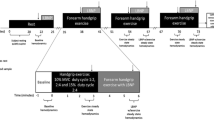Abstract
The responses in heart rate, blood pressure and blood flow in the resting forearm during contralateral isometric handgrip were investigated together with the respiratory sinus arrhythmia (measured during standardized breathing frequency and depth), and the heart rate response to a Valsalva manoeuvre in 20 patients with insulin-dependent diabetes and clinical signs of a peripheral neuropathy. The respiratory sinus arrhythmia and the Valsalva ratio were attenuated in the patients compared to age-matched controls, indicating reduced vagal function. Also the responses to handgrip were reduced. The blood flow increase in the resting forearm upon handgrip was correlated with both the respiratory sinus arrhythmia and the Valsalva ratio, supporting neurogenic mediation of the flow response and indicating a reduction in sympathetic as well as vagal function in diabetes autonomic neuropathy.
Similar content being viewed by others
References
Ellenberg M. Current status of diabetic neuropathy.Metabolism 1973;22: 657–671.
Rundles RW. Diabetic neuropathy. General review with report of 125 cases.Medicine 1945;24: 111–125.
Clarke BF, Ewing DJ, Campbell IW. Diabetic autonomic neuropathy.Diabetologia 1979;17: 195–212.
Keen H. Autonomic neuropathy in diabetes mellitus.Post Grad Med 1954;35: 272–284.
Page MM, Watkins PJ. The heart in diabetes: autonomic neuropathy and cardiomyopathy.J Clin Endocrin Metab 1971;6: 377–386.
Baldwa VS, Ewing DJ. Heart rate response to Valsalva manoeuvre.Br Heart J 1977;39: 641–644.
Eklund B, Kaijser L, Knutsson E. Blood flow in resting (contralateral) arm and leg during isometric contraction.J Physiol 1974;240: 111–124.
Eklund B, Kaijser L. Effect of regional alpha and betaadrenergic blockade on blood flow in the resting forearm during contralateral isometric handgrip.J Physiol 1976;262: 39–50.
Lind AR, Dahms TE, Williams CA, Petrofsky JS. The blood flow through the ‘resting’ arm during hand-grip contractions.Circulation Res 1981;48: 104–109.
Kaijser L, Sachs C. Autonomic cardiovascular responses in old age.Clin Physiol 1985;5: 347–357.
Rusch NJ, Shepherd JT, Webb RC, Vanhoutte PM. Different behaviour of the resistance vessels of the human calf and forearm during contralateral isometric exercise, mental stress and abnormal respiratory movements.Circulation Res 1981;48: 118–130.
Sigroth K. Reflex vasodilatation of the fingers in the study of peripheral vascular disorders.Acta Med Scand 1957;157 (suppl. 325): 1–116.
Berglund B, Wajngot A, Freyschuss U, Milentievic, Efendic S. Cardiovascular reflexes in short-term diabetics with normal physical working capacity.Scand J Clin Lab Invest 1980;40: 749–753.
Author information
Authors and Affiliations
Rights and permissions
About this article
Cite this article
Kaijser, L. Neurogenic forearm vasodilatation during contralateral isometric exercise is attenuated in diabetes mellitus. Clinical Autonomic Research 1, 239–242 (1991). https://doi.org/10.1007/BF01824993
Received:
Accepted:
Issue Date:
DOI: https://doi.org/10.1007/BF01824993




